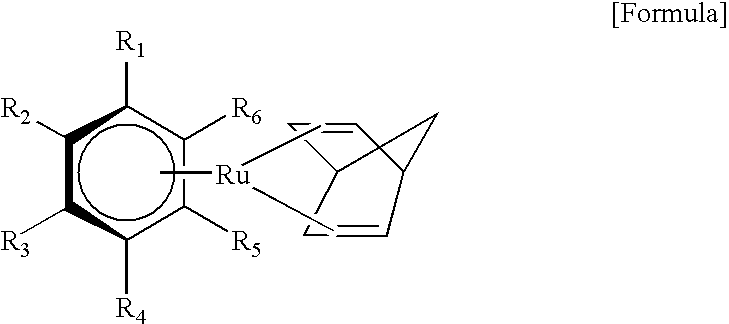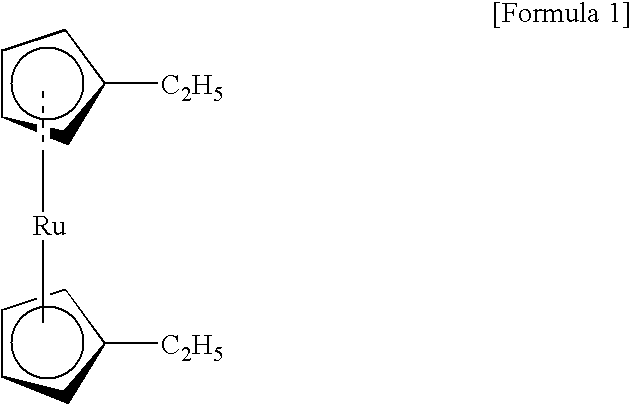Organic ruthenium compound for chemical vapor deposition, and chemical vapor deposition method using the organic ruthenium compound
a technology which is applied in the field of organic ruthenium compound for chemical vapor deposition and chemical vapor deposition method using organic ruthenium compound, can solve the problems of deterioration in morphology and electric properties of the produced thin film, and achieve good handleability and recyclability
- Summary
- Abstract
- Description
- Claims
- Application Information
AI Technical Summary
Benefits of technology
Problems solved by technology
Method used
Image
Examples
example 1
[0020]In Example 1, (norbornadiene)(toluene)ruthenium, as the organoruthenium compound represented by Formula 4 above, was produced. Into a 5 L three-necked flask, 50.4 g of ruthenium chloride hydrate (ruthenium content: 39.6%), 2300 mL of ethanol and 52.1 g of 1-methyl-1,4-cyclohexadiene were introduced, and the reaction mixture was refluxed at 78° C. for 4 hours. The produced brown powder was filtered out, washed with 300 mL of methanol three times, followed by drying overnight in a vacuum drier to obtain 48.21 g of [Ru(toluene)Cl2]2. The yield of the product by this reaction was 92.5%.
[0021]Then, 15.9 g of [Ru(toluene)Cl2]2 produced by the above reaction, 82.8 g of sodium carbonate, 55.5 g of norbornadiene and 3000 mL of isopropanol were put into a 5 L three-necked flask, and the reaction mixture was refluxed at 81° C. for one hour. After the reaction, the reaction solution was filtered, the filtrate was heated to remove isopropanol and excess norbornadiene, and 1000 mL of hexane...
example 2
[0022]In Example 2, (norbornadiene)(p-cymene)ruthenium, as the organoruthenium compound represented by Formula 5 above, was produced. Into a 5 L three-necked flask, 50.4 g of ruthenium chloride hydrate (ruthenium content: 39.6%), 2300 mL of ethanol and 306.6 g of α-phellandrene were introduced, and the reaction mixture was refluxed at 78° C. for 4 hours. The produced brown powder was filtered out, washed and dried in the same manner as in Example 1 to obtain 47.05 g of [Ru(p-cymene)Cl2]2. The yield of the product by this reaction was 77.4%.
[0023]Then, 18.4 g of [Ru(p-cymene)Cl2]2 produced by the above reaction, 82.8 g of sodium carbonate, 55.5 g of norbornadiene and 3000 mL of isopropanol were put into a 5 L three-necked flask, and the reaction mixture was refluxed at 81° C. for one hour. After the reaction, filtration of the reaction solution, removal of isopropanol etc., and extraction of the necessary constituent were performed in the same manner as in Example 1. After removing h...
example 3
[0024]In Example 3, (norbornadiene)(hexamethylbenzene)ruthenium, as the organoruthenium compound represented by Formula 6 above, was produced. Into a 2 L three-necked flask, 40.0 g of [Ru(p-cymene)Cl2]2 produced in Example 2 and 195.0 g of hexamethylbenzene were introduced, and the reaction mixture was refluxed at 180° C. for 4 hours. The obtained solid was washed with hexane and toluene and dried to obtain 37.6 g of [Ru(hexamethylbenzene)Cl2]2. The yield of the product by this reaction was 88.1%.
[0025]Then, 23.3 g of [Ru(hexamethylbenzene)Cl2]2 produced by the above reaction, 82.8 g of sodium carbonate, 55.5 g of norbornadiene and 3000 mL of isopropanol were put into a 5 L three-necked flask, and the reaction mixture was refluxed at 81° C. for one hour. After the reaction, filtration of the reaction solution, removal of isopropanol etc., and extraction of the necessary constituent were performed in the same manner as in Example 1. After hexane was removed from the extract, the extr...
PUM
| Property | Measurement | Unit |
|---|---|---|
| deposition rate | aaaaa | aaaaa |
| temperature | aaaaa | aaaaa |
| morphology | aaaaa | aaaaa |
Abstract
Description
Claims
Application Information
 Login to View More
Login to View More - R&D
- Intellectual Property
- Life Sciences
- Materials
- Tech Scout
- Unparalleled Data Quality
- Higher Quality Content
- 60% Fewer Hallucinations
Browse by: Latest US Patents, China's latest patents, Technical Efficacy Thesaurus, Application Domain, Technology Topic, Popular Technical Reports.
© 2025 PatSnap. All rights reserved.Legal|Privacy policy|Modern Slavery Act Transparency Statement|Sitemap|About US| Contact US: help@patsnap.com



